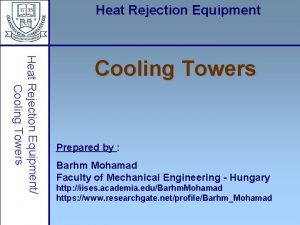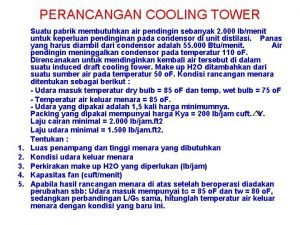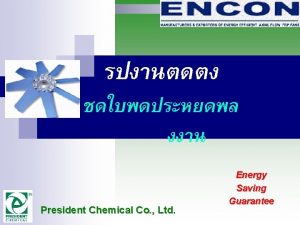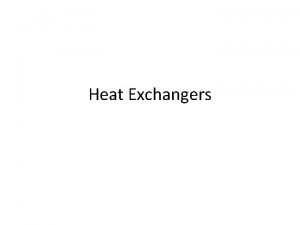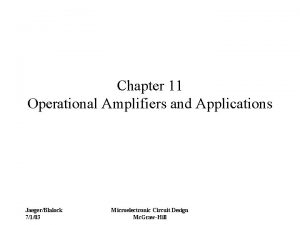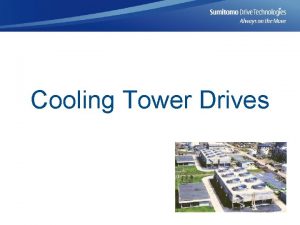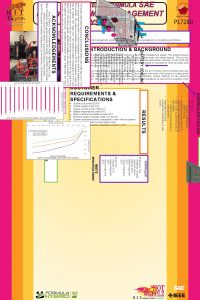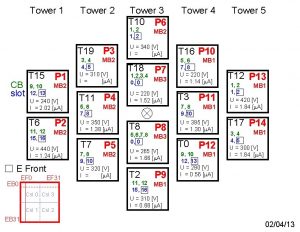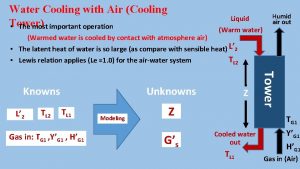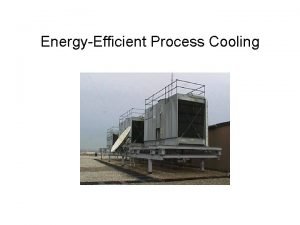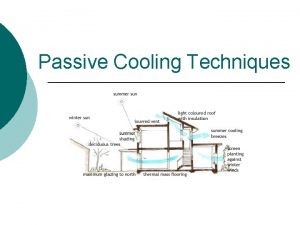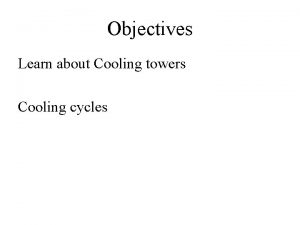Cooling tower is A heat rejection device which



















- Slides: 19


Cooling tower is : A heat rejection device, which extracts waste heat to the atmosphere through the cooling of a water stream to a lower temperature. Moist, warm air out Hot water Heat rejection device (cooling tower) Dry air in Cold water

Remove heat from the water discharged from the condenser so that the water can be discharged to the river or recirculated and reused.

Cross flow is a design in which the air flow is directed perpendicular to the water flow (see diagram below). Air flow enters one or more vertical faces of the cooling tower to meet the fill material. Water flows (perpendicular to the air) through the fill by gravity.

Counter flow In a counter flow design the air flow is directly opposite of the water flow (see diagram below). Air flow first enters an open area beneath the fill media and is then drawn up vertically. The water is sprayed through pressurized nozzles and flows downward through the fill, opposite to the air flow.

1 -Mechanical cooling tower. 2 -natural draft cooling tower. 3 -Induced draft cooling tower. 4 -Forced draft cooling tower.

Basic components: 1 -Frame and casing: Most towers have structural frames that support the exterior enclosures (casings), motors, fans, and other components. With some smaller designs, such as some glass fiber units, the casing may essentially be the frame.

Fill: Most towers employ fills (made of plastic or wood) to facilitate heat transfer by maximizing water and air contact. Fill can either be splash or film type. With splash fill, water falls over successive layers of horizontal splash bars, continuously breaking into smaller droplets, while also wetting the fill surface. Plastic splash fill promotes better heat transfer than the wood splash fill. Film fill consists of thin, closely spaced plastic surfaces over which the water spreads, forming a thin film in contact with the air. These surfaces may be flat, corrugated, honeycombed, or other patterns. The film type of fill is the more efficient and provides same heat transfer in a smaller volume than the splash fill.

Nozzles: These provide the water sprays to wet the fill. Uniform water distribution at the top of the fill is essential to achieve proper wetting of the entire fill surface. Nozzles can either be fixed in place and have either round or square spray patterns or can be part of a rotating assembly as found in some circular cross-section towers.

FAN: The fan is directly driven, axial flow type fans are specially designed to ensure AEROFOIL Section throughout the blade length, this ensure energy saving and generates maximum air flow at minimum pitch angle of blades in the cooling towers. Fans are electronically balanced made of light weight Aluminum casting. Fans are durable, corrosion resistant and low noise delivering high flow.

Motor and gear reducer system FAN MOTOR: The motor is totally weatherproof construction, suitable for heated and humid atmosphere. Special low RPM totally enclosed motor of vertical, flange type with enlarged threaded shaft and sealed top is supplied with the cooling tower.

Drift eliminators: These capture water droplets entrapped in the air stream that otherwise would be lost to the atmosphere. Louvers: Generally, cross-flow towers have inlet louvers. The purpose of louvers is to equalize air flow into the fill and retain the water within the tower. Many counter flow tower designs do not require louvers. Cold water basin: The cold water basin, located at or near the bottom of the tower, receives the cooled water that flows down through the tower and fill. The basin usually has a sump or low point for the cold water discharge connection. In many tower designs, the cold water basin is beneath the entire fill.

Pumps of cooling tower: Loop Pumps Cooling Tower Spray Pumps

Natural draft, which utilizes buoyancy via a tall chimney. Warm, moist air naturally rises due to the density differential to the dry, cooler outside air. Warm moist air is less dense than drier air at the same temperature and pressure. This moist air buoyancy produces a current of air through the tower. This photo shows a single natural draft cooling tower as used at a European plant. Natural draft towers are typically about 400 ft (120 m) high, depending on the differential pressure between the cold outside air and the hot humid air on the inside of the tower as the driving force. No fans are used.

The green flow paths show the water is taken from a river (yellow) to an intake supply basin (green) that the Circ Water Pumps take suction from. The water is then pumped to the Condenser where the water is heated. The water is then sent to an exit distribution basin where the water then can be returned to the river and/or pumped by the Cooling Tower Pumps to the Cooling Towers then the water returned to the intake supply basin where the water can be reused.


Cooling towers with malfunctions can freeze during very cold weather. Typically, freezing starts at the corners of a cooling tower with a reduced or absent heat load. Increased freezing conditions can create growing volumes of ice, resulting in increased structural loads. During the winter, some sites continuously operate cooling towers with 40 °F water leaving the tower. Basin heaters, tower drain down, and other freeze protection methods are often employed in cold climates.

A mechanical draft tower with a fan at the discharge which pulls air through tower. The fan induces hot moist air out the discharge. This produces low entering and high exiting air velocities, reducing the possibility of recirculation in which discharged air flows back into the air intake. This fan/fill arrangement is also known as draw -through.

A mechanical draft tower with a blower type fan at the intake. The fan forces air into the tower, creating high entering and low exiting air velocities. The low exiting velocity is much more susceptible to recirculation. With the fan on the air intake, the fan is more susceptible to complications due to freezing conditions. Another disadvantage is that a forced draft design typically requires more motor horsepower than an equivalent induced draft design. The forced draft benefit is its ability to work with high static pressure. They can be installed in more confined spaces and even in some indoor situations. This fan/fill geometry is also known as blow-through.
 Cooling tower approach temperature
Cooling tower approach temperature Perancangan cooling tower
Perancangan cooling tower Cooling tower water treatment training
Cooling tower water treatment training Encon fans
Encon fans Hardware output
Hardware output Scraped heat exchanger
Scraped heat exchanger Heat pipes for electronics cooling applications
Heat pipes for electronics cooling applications Classic fashion cycle
Classic fashion cycle Rejection ultrasound physics
Rejection ultrasound physics Sample rejection criteria
Sample rejection criteria Sample rejection criteria
Sample rejection criteria Www.elishagoodman.org
Www.elishagoodman.org When blood sample hemolyzed
When blood sample hemolyzed Reassurance dalam hubungan
Reassurance dalam hubungan Image frequency rejection ratio
Image frequency rejection ratio Defect rejection ratio formula
Defect rejection ratio formula Common mode rejection ratio
Common mode rejection ratio Dependency rejection
Dependency rejection Opposite of acceptance
Opposite of acceptance Load rejection overvoltage
Load rejection overvoltage
